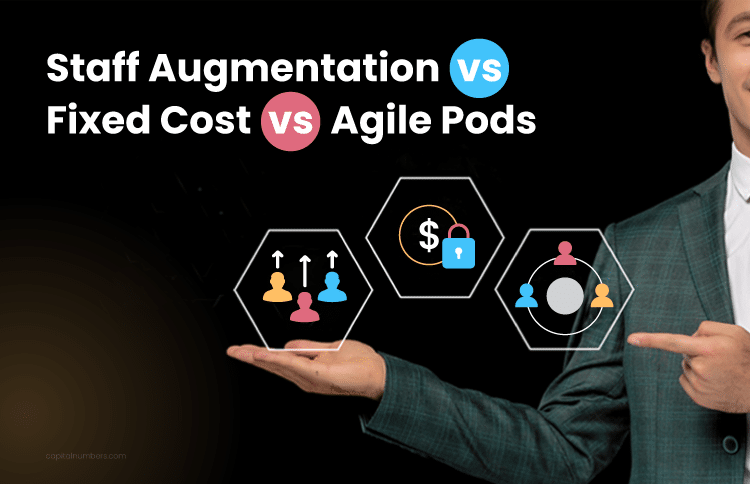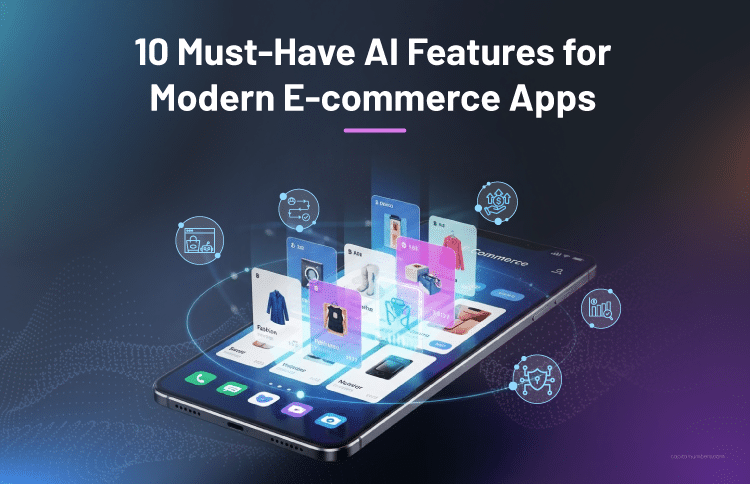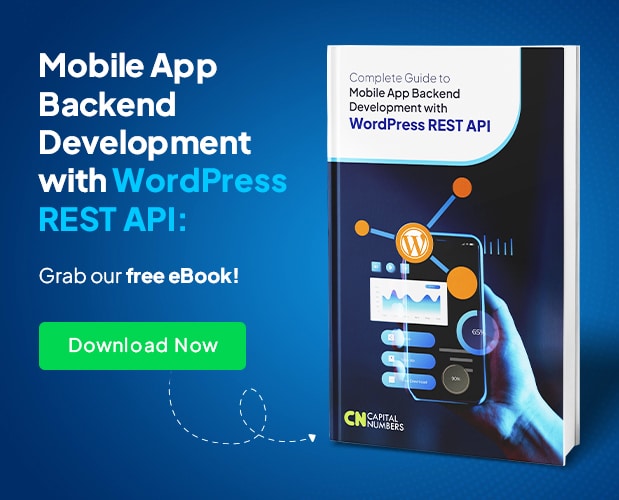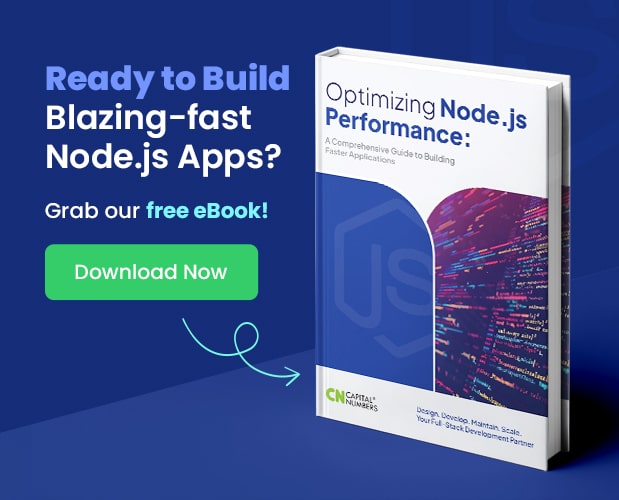Staff Augmentation vs Fixed Cost vs Agile Pods: Which One to Choose for Your Project
Table of Contents
Global software development is changing fast, and companies are under more pressure to deliver projects quicker, better, and cheaper. The IT outsourcing market reflects this trend, expected to grow at a compound annual growth rate (CAGR) of 8.28% from 2025 to 2029, reaching a staggering US$812.71 billion by 2029 (Source: Statista).
With this growth, choosing the right way to work with software teams is more important and confusing than ever. Whether it’s Staff Augmentation, Fixed Cost, or Agile Pods, each has its benefits and challenges. Picking the right model that fits your project, budget, and risk level can make a big difference in your project’s success.
This guide provides a comparison of Staff Augmentation, Fixed Cost, and Agile Pods software development models, highlighting real examples, pros and cons, and key insights to help you choose the best approach for your next project.
What is Staff Augmentation?
Staff Augmentation is a flexible staffing model that allows you to add skilled software developers or IT specialists to your existing team for a short or long period. These professionals are provided by a partner company and integrate seamlessly with your in-house team to help complete projects or address specific skill gaps.
This approach is ideal for companies that need extra expertise quickly but want to avoid the time and cost involved in hiring full-time employees. By using Staff Augmentation, you retain direct control over managing the augmented team while benefiting from the additional resources needed to meet project demands.
How Does It Work?
In this model, your company tells a service provider what talent you need, like a backend developer, mobile app developer, or tester. The provider gives you professionals who match those needs. These team members work with you just like your regular employees. They follow your tools, processes, and schedules, but the service provider officially employs them.
This gives you more control than outsourcing software projects, where a vendor handles everything. It’s also more flexible than Fixed Cost software development, where the full scope and price are decided in advance.
Types of Staff Augmentation
There are a few different types of Staff Augmentation based on where the team members work:
- On-site: The developers work from your office
- Remote: They work from their location and connect with your team online.
- Nearshore: They are located in a nearby country with a similar time zone.
- Offshore: They work from a distant country, often with lower costs (like India or Eastern Europe).
These options allow you to choose what fits your project and budget best.
You May Also Read: Offshore Software Development in 2025: Myths vs. Facts
Benefits
Here are the key benefits of Staff Augmentation:
- Flexible team size: Add or reduce people as you need.
- Quick hiring: Start work faster without long recruitment.
- More control: You manage the work directly.
- Lower costs: No need to handle payroll or HR tasks.
Drawbacks
The following are the cons of Staff Augmentation:
- Management Responsibility: You still need to supervise the augmented team.
- Onboarding Time: External team members may need time to adapt.
- Communication Gaps: Time zones or remote work can sometimes cause delays.
What is Fixed Cost Engagement?
Fixed Cost software development is a pricing model in which the total project cost is agreed upon upfront, before any work starts. In this model, the project’s scope, timelines, and budget are clearly defined and locked in at the beginning. This approach works best when you have a well-defined project with clear requirements and minimal expected changes during development.
As everything is planned in detail ahead of time, Fixed Cost projects offer predictability in both cost and schedule, making it easier to manage budgets and timelines. However, this model is less flexible if you need to adapt or add features once development is underway.
Process Flow
Here’s how a Fixed Cost engagement usually works:
- Requirement Gathering: You share detailed project requirements with the development team.
- Estimation: The team reviews the scope and provides you with a time and cost estimate.
- Agreement: Both sides agree on the fixed budget, scope, and delivery timeline.
- Development Starts: The team builds the software based on the agreed plan.
- Delivery & Testing: Once the product is ready, it’s tested and delivered to you within the deadline.
Everything is mapped out from the beginning, so the process runs in a clear and predictable way.
Key Characteristics
Here are the main features of this outsourcing model:
- Pre-defined Scope: All features and functionalities are finalized before the project begins.
- Fixed Budget: The cost remains the same even if the development takes more effort.
- Predictable Timelines: Deadlines are set early, helping with planning and coordination.
- Limited Flexibility: Changes in requirements after the project starts may lead to extra charges or delays.
This model is common in custom software development projects that have a clear goal and detailed documentation.
Benefits
Here we have listed down the ways the Fixed Cost hiring model benefits you:
- Budget Control: You know the total cost upfront, making it easier to plan.
- Low Risk: Since the scope is fixed, there are fewer surprises.
- Simple Process: The step-by-step flow makes it easy to manage.
- Focus on Delivery: The team is focused on finishing the agreed work on time.
If you’re focused on balancing software development cost and quality, this model helps you stay in control without overpaying.
Drawbacks
Below are the common cons of this outsourcing model:
- Less Flexibility: If your needs change during the project, it may cost more or cause delays.
- Not Ideal for Complex Projects: This model is harder to use when things are unclear or might evolve.
- Longer Planning Time: You must invest time upfront to finalize everything before development starts.
What Are Agile Pods?
Agile Pods are small, focused teams that work closely together to build and deliver software quickly and flexibly. Each pod is responsible for a specific part of a project, such as a feature or a section of an app. Agile Pods follow the Agile methodology, a way of working that breaks projects into short, manageable cycles called sprints (usually 1 to 3 weeks). This approach encourages continuous improvement and quick adaptation to changes.
Agile Pods are especially effective for outsourcing software projects where your requirements may evolve over time. They help balance cost and quality by focusing on steady progress, regular feedback, and close collaboration.
Team Composition
Each Agile Pod usually includes:
- Developers: Build and write the code.
- Testers (QA): Make sure everything works well.
- Designers (UI/UX): Create easy and good-looking screens.
- Project Manager or Scrum Master: Keep the team organized and remove blockers.
- (Sometimes) Business Analyst: Helps the team understand what the business needs.
This mix of roles helps the team handle the entire task from start to finish.
You May Also Read: Agile and Scrum for Sustainable Delivery
Agile Delivery Cycle
Agile Pods work in short time frames. Each sprint follows this cycle:
- Plan: The team picks tasks to work on.
- Develop: They build and test the features.
- Review: The work is shown to get feedback.
- Improve: The team discusses what went well and what could be better.
This process keeps the team focused and allows quick changes if needed. It’s one reason why Agile Pods are widely adopted to ensure successful software development outsourcing.
Ownership and Accountability
Agile Pods take full responsibility for their work. This means:
- They decide how to do the work.
- They manage their own time.
- They test and check quality before delivery.
This clear ownership helps keep things on track and makes communication easier between your team and the outsourcing partner.
Benefits
The chief advantages of the Agile Pods model include the following:
- Faster results: Work is delivered in small, quick steps.
- Good teamwork: Small teams talk and work closely.
- Can adjust easily: Changes are easy to handle.
- Full responsibility: One team handles everything on their part.
- Easy to scale: Add more pods as the project grows.
Drawbacks
Like other software development models, Agile Pods is not free from shortcomings. Its disadvantages include:
- Needs strong communication: Pods need to stay in sync with other teams.
- Not for all projects: Simple or fixed-scope projects may not need full pods.
- Onboarding takes time: Assembling the right team and aligning workflows may require extra setup time.
You May Also Read: Adaptive Software Development: The Agile Approach for Modern Projects
Comparing Staff Augmentation, Fixed Cost, and Agile Pods
Choosing the right engagement model can make or break your software project. Whether you aim for flexibility, predictability, or end-to-end delivery ownership, comparing Staff Augmentation, Fixed Cost, and Agile Pods helps you make a wise decision.
Flexibility
- Staff Augmentation provides the most flexibility. You can quickly ramp up or scale down based on project needs or skill gaps.
- Fixed Cost is rigid; any change beyond the agreed scope often requires a formal change request.
- Agile Pods strike a balance, offering some flexibility within structured sprint cycles.
Scope of Work
- Staff Augmentation is ideal for ongoing or undefined scopes. You decide tasks and priorities.
- Fixed Cost is best for well-scoped projects, like short-term or custom software development with clear deliverables.
- Agile Pods suit dynamic, evolving projects with shifting requirements.
Client Involvement
- Staff Augmentation demands high client involvement. You’re responsible for assigning tasks and managing performance.
- Fixed Cost minimizes your involvement after the initial planning.
- Agile Pods require moderate involvement – you set the goals, but the pod drives execution.
Cost and Value
- Staff Augmentation is cost-effective when used correctly, especially for long-term engagements.
- Fixed Cost software development gives upfront pricing, which helps with budgeting, but it may become expensive if the scope changes often.
- Agile Pods cost more than freelancers or contractors, but deliver high value through collaboration, ownership, and faster time to market.
Speed to Start
- Staff Augmentation can start quickly, which is ideal when timelines are tight.
- Fixed Cost involves documentation, estimates, and contracts, delaying kick-off.
- Agile Pods take longer to organize due to team assembly and alignment, but offer stability and productivity long-term.
Team Ownership
- In Staff Augmentation, you own the process; the external team integrates with your internal one.
- With Fixed Cost, the vendor owns the outcome, but only within the agreed scope.
- Agile Pods offer shared ownership. The pod takes full responsibility for delivery, while staying aligned with your goals.
Risk Management
- Staff Augmentation transfers minimal risk to the vendor – you remain accountable for delivery.
- Fixed Cost shifts risk to the vendor, since delivery must happen within time and budget.
- Agile Pods share risk between the pod and client, using continuous feedback to minimize project failure.
Quality Control
- In Staff Augmentation, you control code quality, testing, and processes.
- In Fixed Cost, vendors manage quality, but often within tight budgets and deadlines.
- Agile Pods are designed for continuous improvement – built-in QA, regular retrospectives, and iterative delivery promote high-quality outcomes.
You May Also Read: Accelerating Software Delivery: DevOps Best Practices for CTOs
Staff Augmentation vs Fixed Cost vs Agile Pods: At a Glance
| Feature | Staff Augmentation | Fixed Cost | Agile Pods |
|---|---|---|---|
| Engagement Type | Add external resources to your internal team | Pre-defined scope with a fixed price | Cross-functional, self-managed team |
| Flexibility | Highly flexible – scale up or down easily | Structured – limited ability to scale up or down | Moderately flexible – adaptable via sprints |
| Scope Suitability | High – you manage tasks, timelines, and deliverables | Low – vendor handles execution | Moderate – client sets goals, pod drives execution |
| Speed to Start | Fast – minimal ramp-up required | Medium – needs planning, documentation | Slower – setup required for team roles and sprint alignment |
| Ownership of Delivery | Client-owned – full control of deliverables | Vendor-owned – but only within the agreed scope | Shared – pod owns delivery, aligned with client objectives |
| Risk Management | Minimal vendor risk – client accountable | The vendor bears delivery risk | Shared risk with iterative improvement |
| Cost & Budgeting | Cost-effective for long-term work and scaling needs | Clear budgeting; best when prioritizing, balancing cost & quality | Higher cost, but high value for an integrated team |
| Quality Control | Managed by the client internally | Managed by vendor; may vary based on cost constraints | Built-in QA, continuous improvement via Agile cycles |
| Best Used for | Long-term team extensions, scaling internal capacity | Short-term or custom software development with fixed features | Complex, large-scale outsourcing software projects with evolving needs |
| Popular In | Resource-based software development outsourcing | Budget-sensitive engagement models in software development | Strategic, value-driven outsourcing models |
Staff Augmentation vs Fixed Cost vs Agile Pods: Our Success Stories
Choosing the right engagement model depends on your project’s goals and requirements. Here are some real-world examples demonstrating how Staff Augmentation, Fixed Cost, and Agile Pods have successfully delivered value to our clients.
Staff Augmentation Success Stories:
a. Modernizing Fintech to Drive Growth
We augmented a fintech company’s team with skilled developers to modernize their platform efficiently. This approach allowed quick scaling while maintaining full control over quality and timelines, helping them deliver critical features faster.
Fixed Cost Success Stories:
a. AI-Powered Radiology Reports
We delivered an AI-powered radiology reporting system on a fixed-cost basis, providing a scalable solution that streamlined diagnostics. Clear scope and timelines ensured budget predictability and timely delivery.
b. E-commerce Order Fulfillment App
Our team built a robust order fulfillment app for an e-commerce platform, managing the entire project scope with clear deliverables and timelines under a fixed-cost model, ensuring budget predictability and high quality.
Agile Pods Success Stories:
a. Real-Time Metal Rates for E-Commerce
Using Agile Pods, we delivered a dynamic platform that updates metal prices in real time, boosting sales and enhancing customer trust with continuous improvements driven by a dedicated agile team.
b. Car Auction Platform with Real-Time Bidding
Our agile pod collaborated closely with the client to build a real-time bidding car auction platform, enabling rapid feature development, iterative feedback, and smooth delivery aligned with evolving business needs.
Hybrid Models: The Best of All Worlds?
Hybrid models mix different software development outsourcing approaches to get the best results for each part of your project during the software development life cycle. This method works best when your project has different parts at different stages or complexities. It helps balance cost, speed, and quality by picking the right model for each part.
Agile Pods + Staff Augmentation
Use Agile Pods for the important, complex parts where a full team works closely together. Add staff augmentation for smaller tasks or to quickly bring in extra experts when needed.
Example: Agile Pods build the main features, while extra developers or testers join as needed.
Fixed Cost + Agile Pods
Use Fixed Cost for simple, clear-cut parts like landing pages or dashboards. Use Agile Pods for core features that need ongoing changes and improvements.
Example: Fixed price for a website, Agile Pods for the app’s main backend.
Fixed Cost + Staff Augmentation
Use Fixed Cost for small projects with set budgets. Use Staff Augmentation to support the project later with extra developers or maintenance help.
Example: Fixed cost for the initial build, then add developers to grow or fix the app.
Decision-Making Framework: What’s Right for You?
Choosing the right software development engagement model depends on several key factors. Use this checklist to guide your decision based on your project’s budget, scope clarity, in-house capacity, project duration, and risk tolerance.
Key Considerations
- Budget: Is your budget fixed or flexible?
- Scope Clarity: Is your project scope well-defined or evolving?
- In-house Capacity: Do you have an internal project manager or team to oversee the work?
- Project Duration: Is the project short-term or long-term?
- Delivery Risk Appetite: How comfortable are you with potential changes or uncertainties?
Sample Questions to Guide You
- Is your scope evolving?
- Yes → Consider Agile Pods or Staff Augmentation for flexibility.
- No → Fixed Cost may be suitable for a well-defined scope.
- Do you have internal project management capacity?
- Yes → Staff Augmentation lets you manage the team directly.
- No → Fixed Cost or Agile Pods provide external management support.
- Are deadlines or budgets more rigid?
- Deadlines and budgets are strict → Fixed Cost offers predictability.
- Deadlines are flexible, but quality and adaptability matter → Agile Pods are better.
Bottom Line
Each software development model – Staff Augmentation, Fixed Cost, and Agile Pods – has advantages and challenges. When you compare these models, you will see that Staff Augmentation offers flexibility and control but needs strong in-house management. Fixed Cost helps maintain budget clarity but can limit adaptability. Agile Pods provide collaborative teamwork and continuous progress, though they may involve higher upfront costs and setup time.
To get the best results, many businesses now use hybrid models that combine these approaches, offering a balanced mix of flexibility, cost efficiency, and quality. At Capital Numbers, we bring deep expertise and a flexible approach to tailor solutions that fit your unique needs.
Not sure which model fits your project? Contact us today for a free consultation to find your best fit.


















